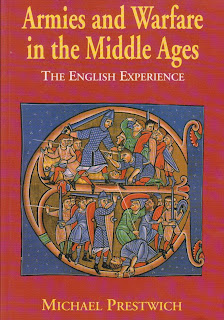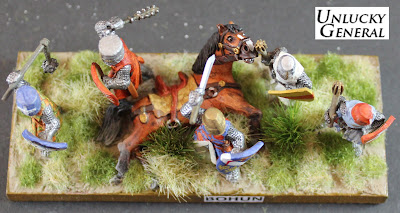Armies & Warfare in the Middle Ages: Review
When it comes to analysis of thirteenth century tactics and doctrine of warfare, there remains a lot yet to be written. Plugging some of the gaps is this worthy tome by Michael Prestwich who concentrates on the English experience with a particular emphasis on the thirteenth and fourteenth centuries, making it a must have for my money. First published in 1996 through Yale University Press, Professor Prestwich (Durham University) draws together every conceivable reference from chronicles to public records, royal records and pictorial studies to paint a picture of how English medieval armies functioned.
I have at this time principally read the chapter dedicated to Infantry (Chapter 5, pp 115-147 2006 reprint) together with his forward and first chapter on the Nature of Medieval Warfare. Whilst reference to particular battles is made and the book provides a vital context to appreciating the army organisations present at the time of Lewes, Professor Prestwich is direct in admitting he is no military analyst. Accordingly, there are still many unanswered questions for students seeking specific theories on field tactics or military doctrine. Within these covers are therefore only some of answers I seek.
A continuing thought nags at my mind: what were the expectations of infantry in defence against mounted assault. I am constantly reminding myself that whilst armoured cavalry was in great evidence at Lewes, the vast bulk of both sides was represented by massed foot soldiery and it was that clash of infantry (after the rout of the Londoners by Prince Edward's cavalry) which decided the day. In many ways, therefore, one might be correct in assessing Lewes as being very much an infantry battle. On speculation and detailed discussion on this type of tactical minutia; however, Armies and Warfare in the Middle Ages remains largely silent.
Recruitment
In summary what can be gleaned from this work, particular to the Infantry of the Lewes campaign, includes matters pertaining to the manner of their call to arms - the Assize of Arms. First introduced by Henry II in 1181, it was not replaced until Edward I adopted the system of Commissions of Array. The Assize set out the duties of the highest to the lowest free men of the realm in equiping himself off a sliding minimum standard of arms and armour, to hold himself fit for service when called to do so. By the mid-thirteenth century the free men found in the ranks are generally of villein, rather than the later yeoman social status. A strictly means tested system, the Assize required our infantry for the period to furnish themselves with no less than a padded jerkin (quilted gambeson), helmet and spear. Certainly the crown did not attempt to equip the freemen or even assist in our period. It is mentioned by Prestwich that the Assize was updated and used several times by Henry III, as it was by Simon de Montfort in 1264 after Lewes.
Quality and Access
A reference to Powicke (from his Select Charters) cites that by this time, only the best sections of men represented through the system were chosen for service. We may presumed that the armies on both sides were certainly well turned out in terms of arms and equipment and dispense with notions of ill equipped rabble attending the march. Whilst the above reference to de Montfort's use of the Assize refers to his access to governmental instruments from his assumption of effective power after victory at Lewes, he no doubt had access to it within those counties and townships sympathetic to his cause or under the direct control of allied barons. The Assize effectively enabled mobilization throughout England on a county or more local level. It would have aided recruitment of effectives the rebels as well as the royalist marshals.
Pay & Longevity
Professional soldiery did not operate beyond small garrison contingents and mercenaries had fallen from favour and practice in England after their exploitation by King John in the First Barons Wars. Nevertheless, the Assize raised men expected to be paid sufficient for their subsistence (2d per day) being at a rate just above that of a labourer, borne by the crown and presumably by Simon de Montfort and his Rebels in chief. The armies were assembled on an 'as needs' basis, generally from localities proximate to the theatre of operations and rarely existed beyond the season or campaign. The desertion rates for home campaigns must have reinforced the necessity for short, sharp actions and armies raised for the purpose.
Organisation
Infantry organisation was before, during and after our period based on a primary unit of 'twenties' with an officer for each, grouped further into 'hundreds' led by a Constable. There is no further unit organisation above the 'hundred' other than the hundreds being assembled into 'wards' or 'battles'.
Other than the spear or hand weapon, Prestwich is convinced that the archer was a principle, if not THE principle infantry figure through the age. His general statement probably inclines toward developments in the later periods of his study. Primacy of archers is not in evidence for Lewes and later armies of the end of the thirteenth and early fourteenth centuries do not generally appear to exceed longbow ratios of more than 1:1 within the ranks of the infantry in any event. As far as foot soldiers defending themselves against cavalry is concerned, Prestwich does state that is was long standing custom to, 'dig pits in front of their positions' (p 136) but offers no clue as to when this may have commenced or how they might have been equipped to do so.
My Shieldwall Theory and Defence in Depth.
I am of the emerging belief that some form of shield wall must have been in common practice throughout the century, never having gone from the doctrine of foot soldiery since the days of Hastings. Unable to outrun, it would have been natural and logical to stand fast in tight formations (drilled or otherwise), bracing themselves for the impact behind stout shields and bristling with spear points. Whilst effective at Hastings combined with the use of the high ground, the numbers of Infantry present at Lewes indicated their importance in battle and perhaps indicated advantages sought from a defence in depth. Imagine, if the impact of the charge could be arrested and general cohesion maintained, even a heavily armoured knight on a destrier presents a viable target when faced with ratios of up to a dozen spearmen each.




Comments